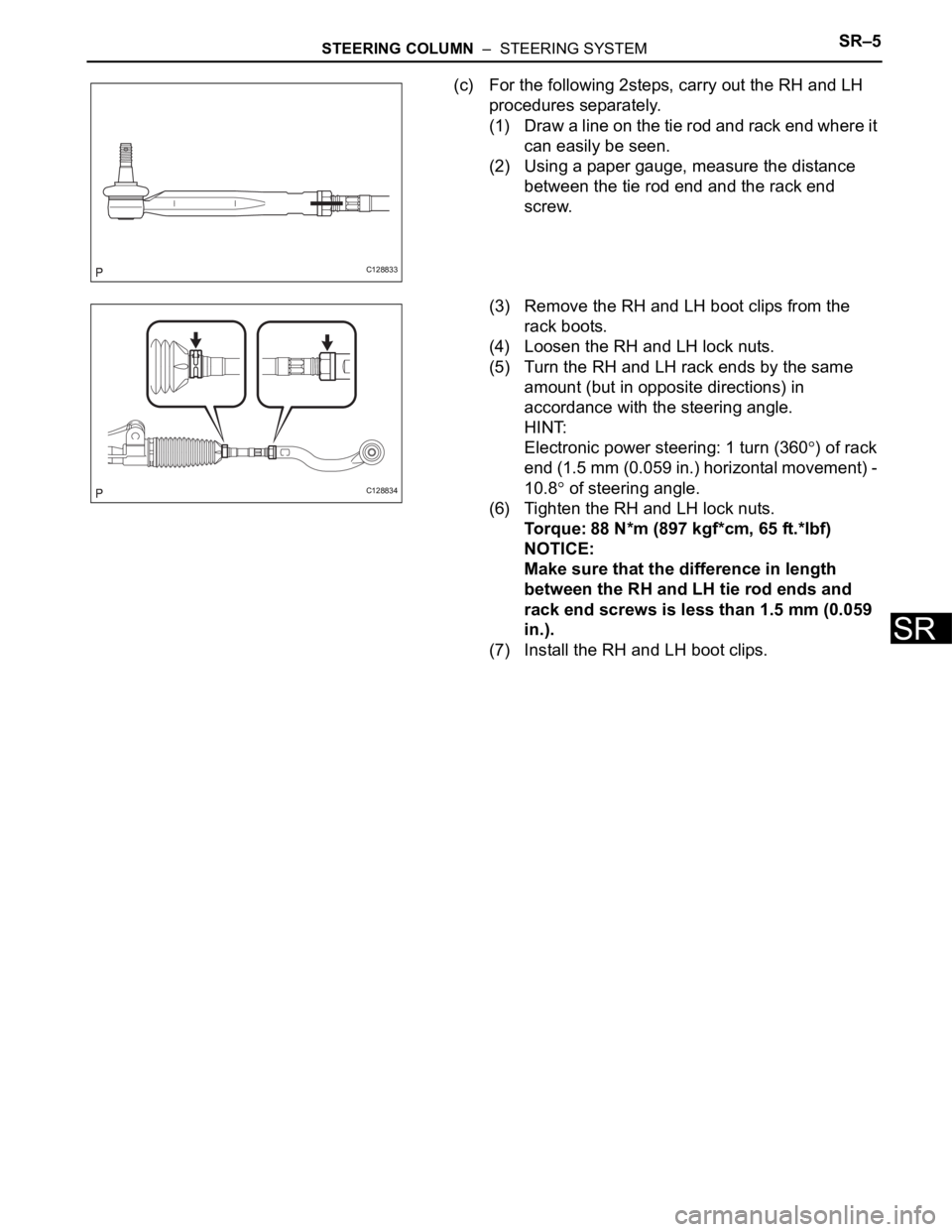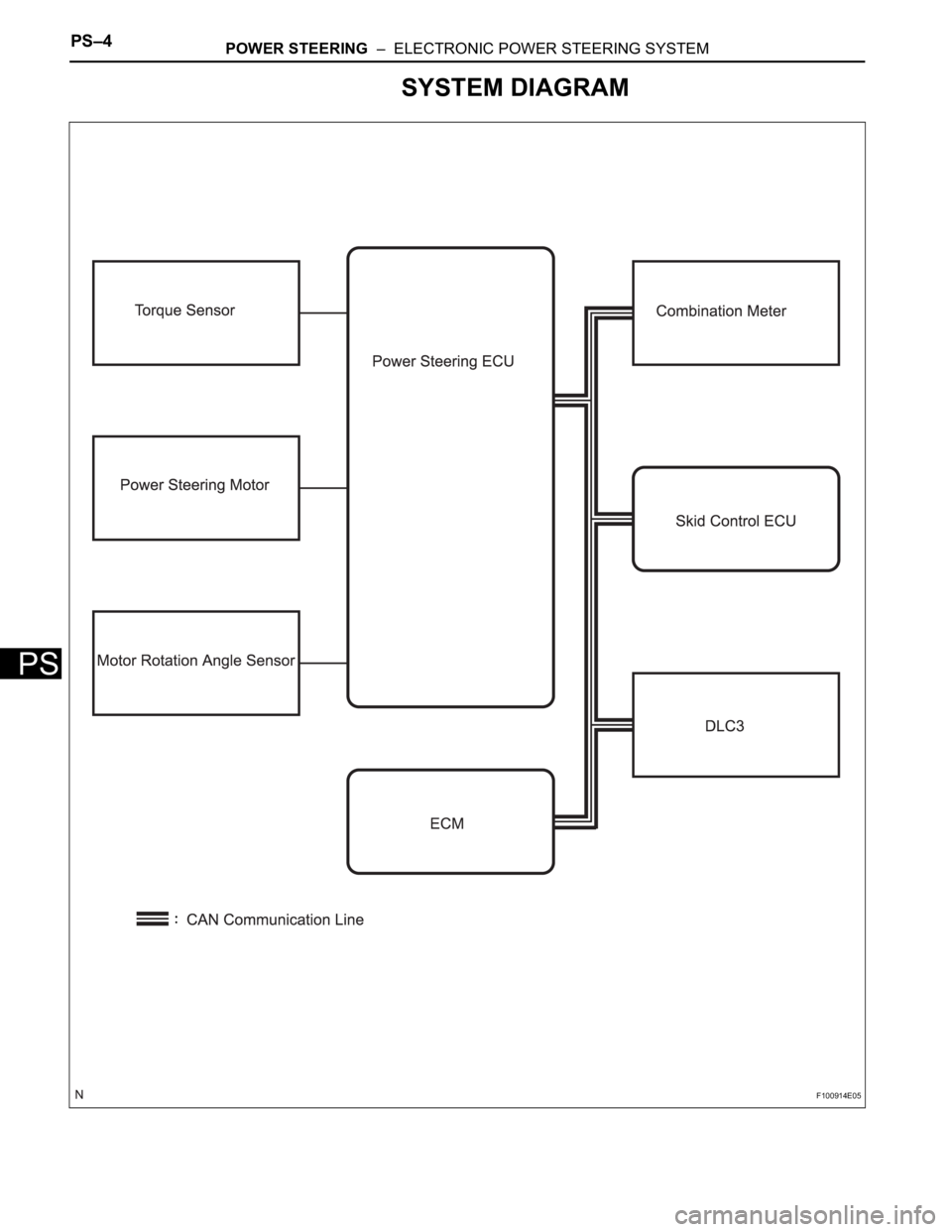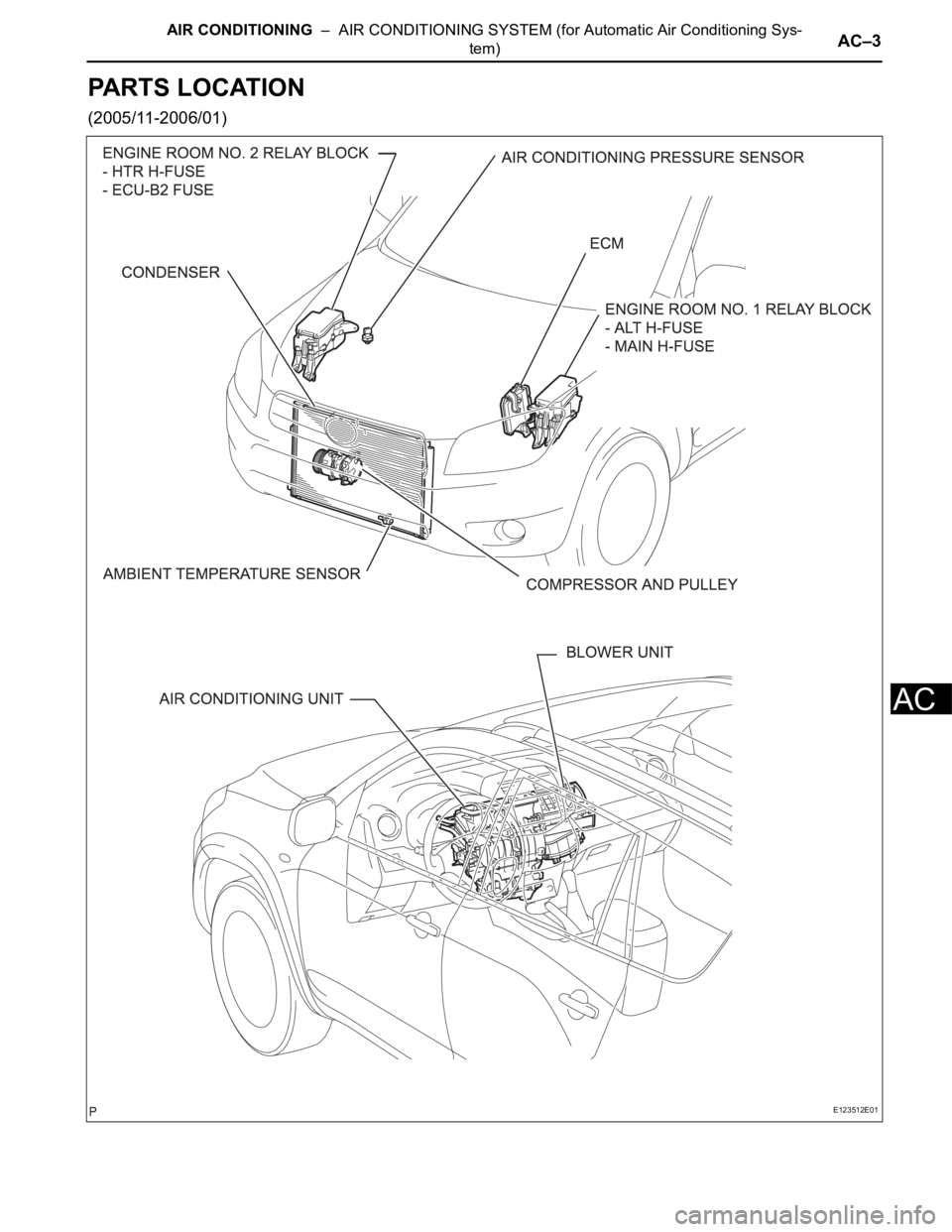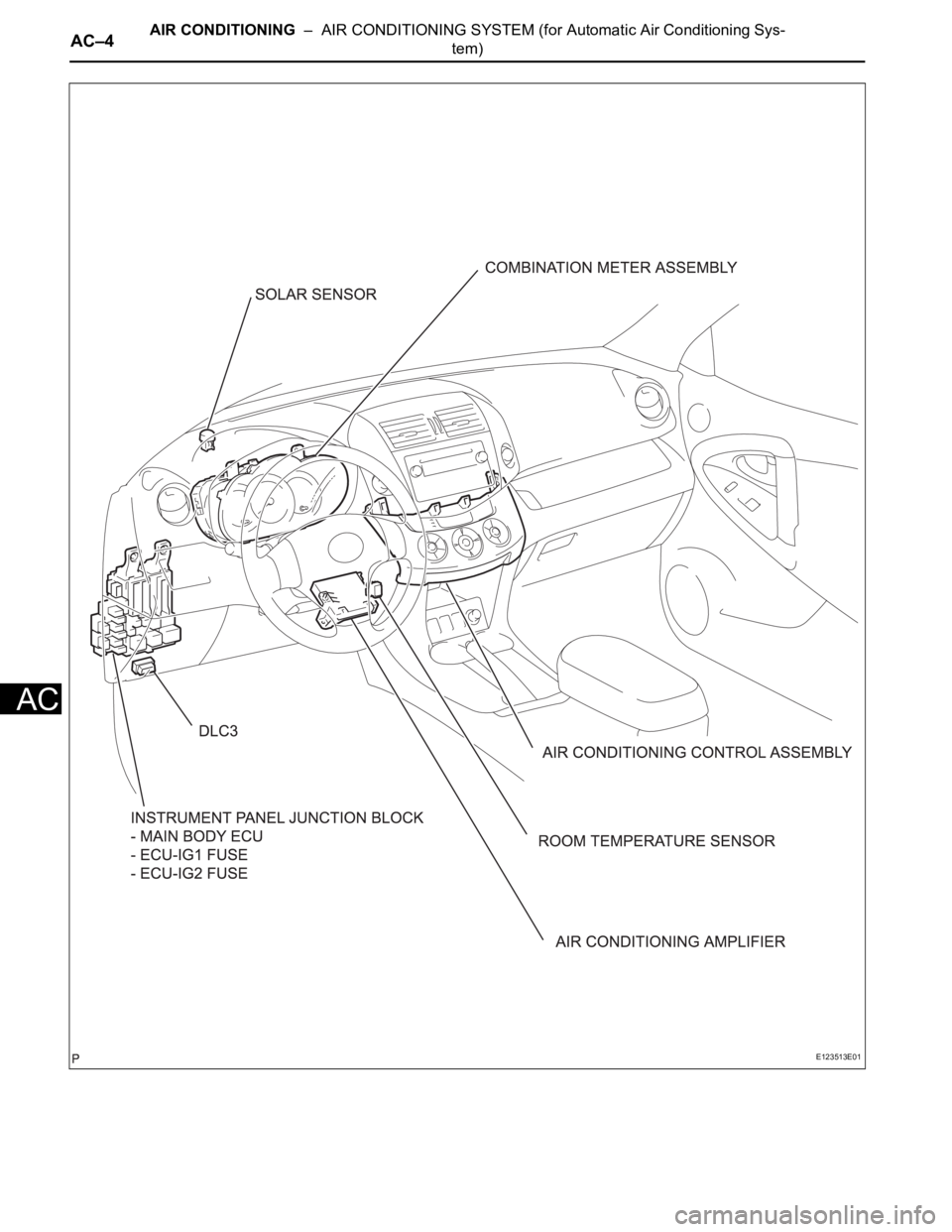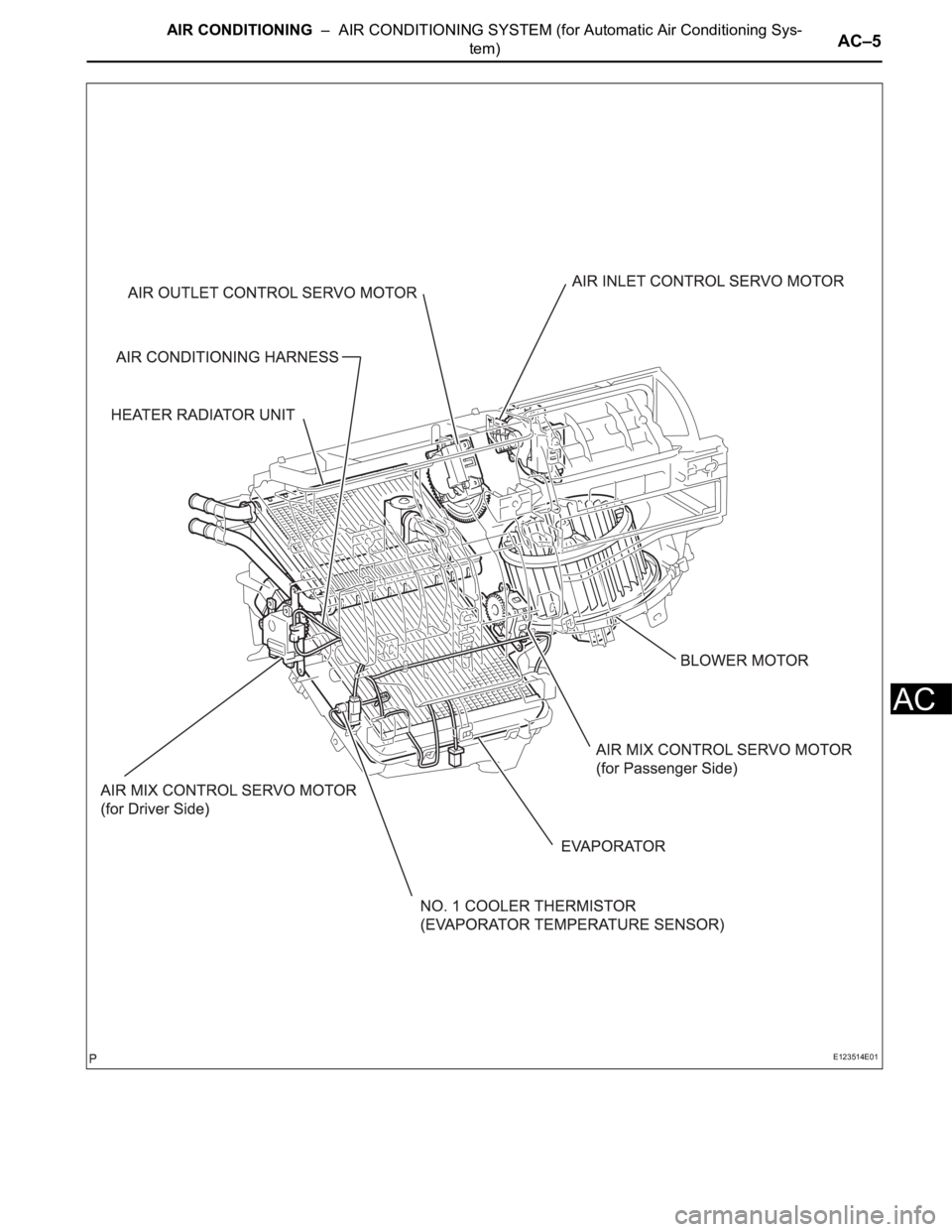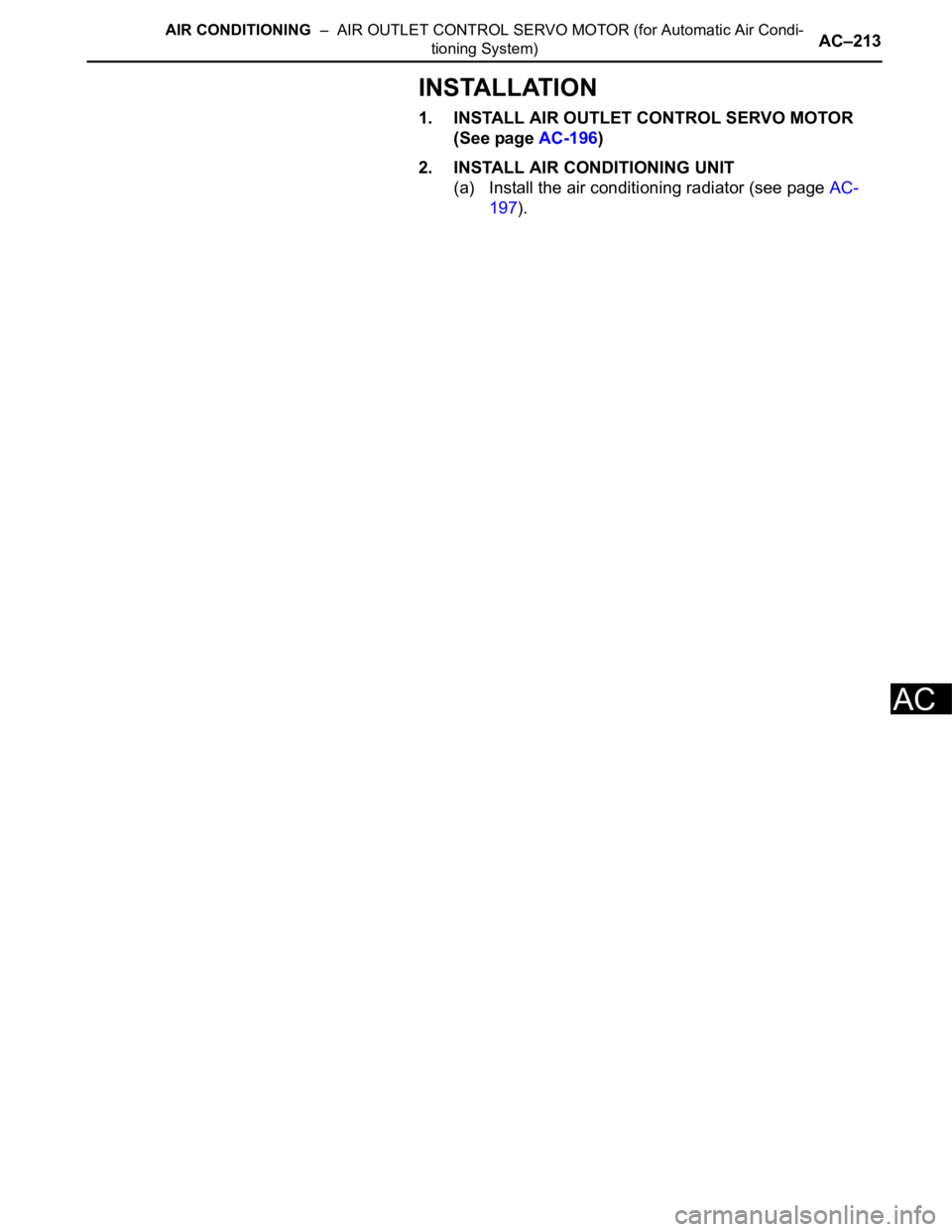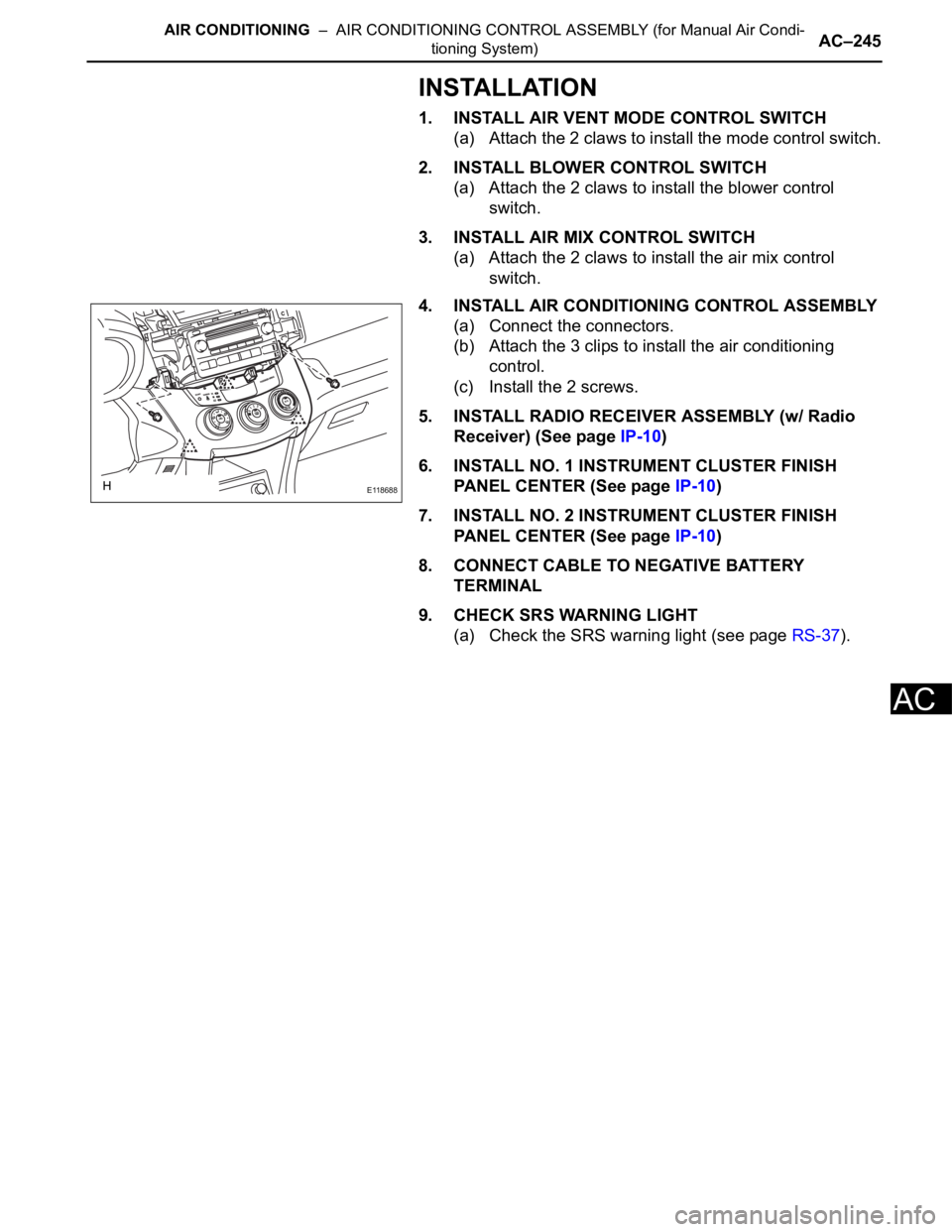TOYOTA RAV4 2006 Service Repair Manual
Manufacturer: TOYOTA, Model Year: 2006,
Model line: RAV4,
Model: TOYOTA RAV4 2006
Pages: 2000, PDF Size: 45.84 MB
TOYOTA RAV4 2006 Service Repair Manual
RAV4 2006
TOYOTA
TOYOTA
https://www.carmanualsonline.info/img/14/57463/w960_57463-0.png
TOYOTA RAV4 2006 Service Repair Manual
Trending: Brake booster, turn signal, layout, engine oil, brake rotor, wiring, oil pressure
Page 421 of 2000
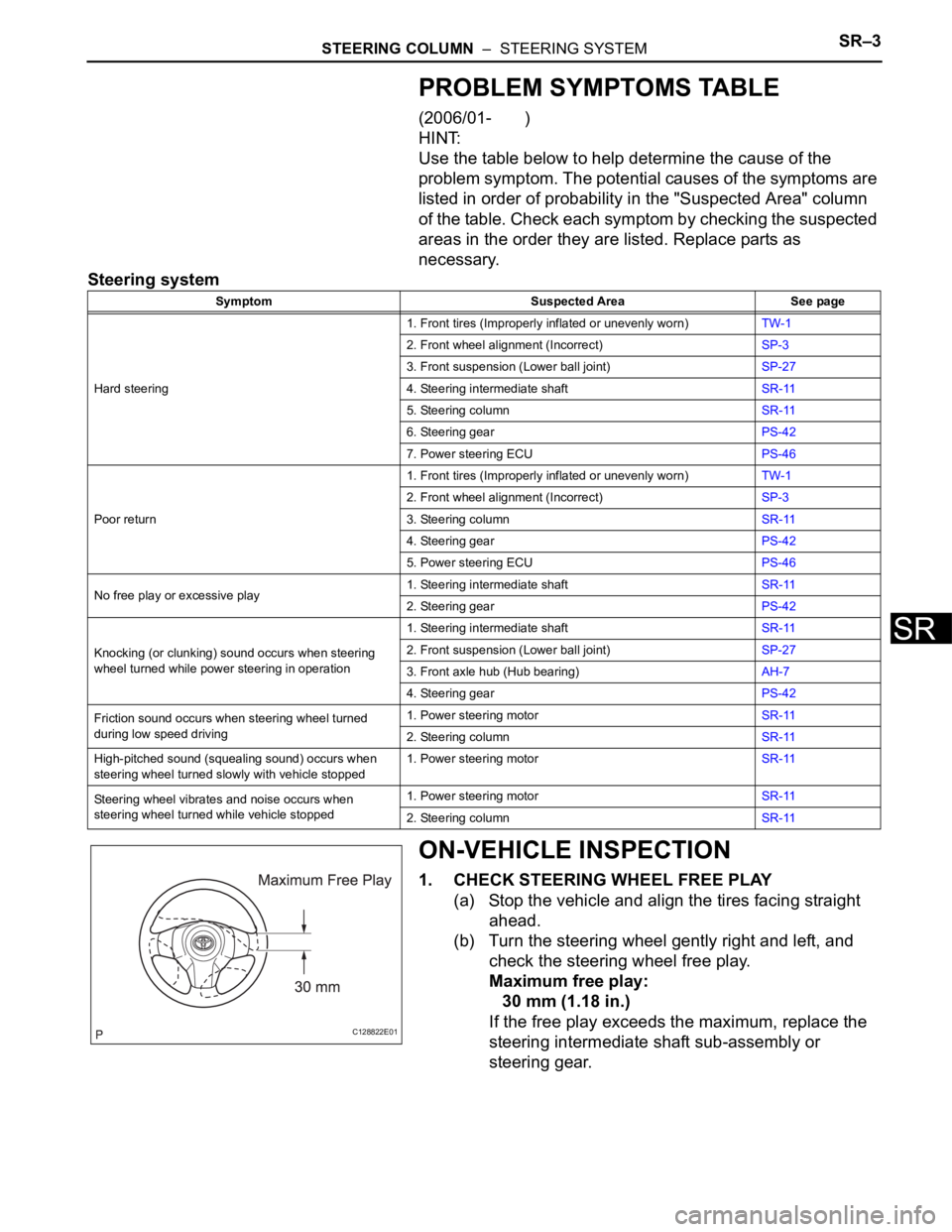
STEERING COLUMN – STEERING SYSTEMSR–3
SR
PROBLEM SYMPTOMS TABLE
(2006/01- )
HINT:
Use the table below to help determine the cause of the
problem symptom. The potential causes of the symptoms are
listed in order of probability in the "Suspected Area" column
of the table. Check each symptom by checking the suspected
areas in the order they are listed. Replace parts as
necessary.
Steering system
ON-VEHICLE INSPECTION
1. CHECK STEERING WHEEL FREE PLAY
(a) Stop the vehicle and align the tires facing straight
ahead.
(b) Turn the steering wheel gently right and left, and
check the steering wheel free play.
Maximum free play:
30 mm (1.18 in.)
If the free play exceeds the maximum, replace the
steering intermediate shaft sub-assembly or
steering gear.
Symptom Suspected Area See page
Hard steering1. Front tires (Improperly inflated or unevenly worn)TW-1
2. Front wheel alignment (Incorrect)SP-3
3. Front suspension (Lower ball joint)SP-27
4. Steering intermediate shaftSR-11
5. Steering columnSR-11
6. Steering gearPS-42
7. Power steering ECUPS-46
Poor return1. Front tires (Improperly inflated or unevenly worn)TW-1
2. Front wheel alignment (Incorrect)SP-3
3. Steering columnSR-11
4. Steering gearPS-42
5. Power steering ECUPS-46
No free play or excessive play1. Steering intermediate shaftSR-11
2. Steering gearPS-42
Knocking (or clunking) sound occurs when steering
wheel turned while power steering in operation1. Steering intermediate shaftSR-11
2. Front suspension (Lower ball joint)SP-27
3. Front axle hub (Hub bearing)AH-7
4. Steering gearPS-42
Friction sound occurs when steering wheel turned
during low speed driving1. Power steering motorSR-11
2. Steering columnSR-11
High-pitched sound (squealing sound) occurs when
steering wheel turned slowly with vehicle stopped1. Power steering motorSR-11
Steering wheel vibrates and noise occurs when
steering wheel turned while vehicle stopped1. Power steering motorSR-11
2. Steering columnSR-11
C128822E01
Page 422 of 2000
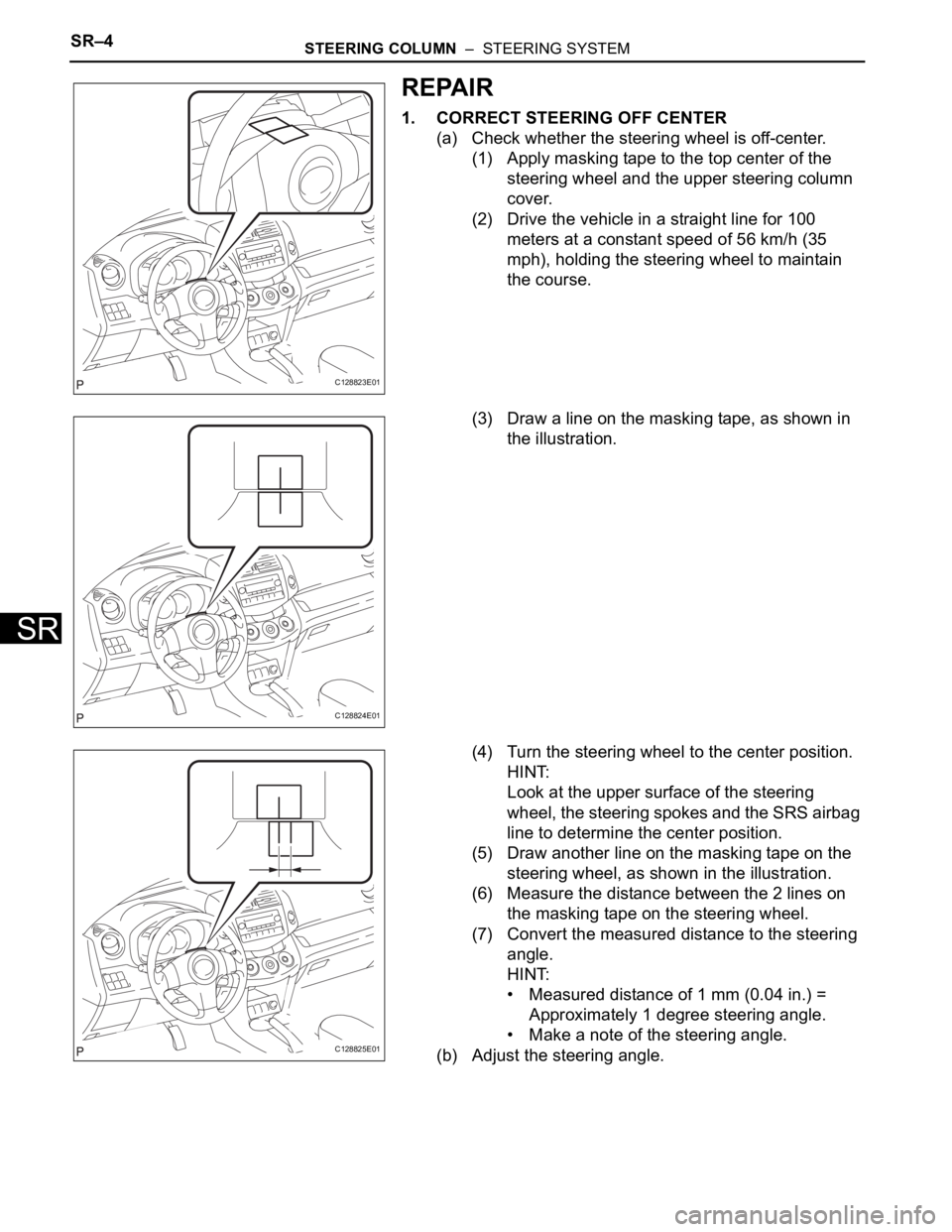
SR–4STEERING COLUMN – STEERING SYSTEM
SR
REPAIR
1. CORRECT STEERING OFF CENTER
(a) Check whether the steering wheel is off-center.
(1) Apply masking tape to the top center of the
steering wheel and the upper steering column
cover.
(2) Drive the vehicle in a straight line for 100
meters at a constant speed of 56 km/h (35
mph), holding the steering wheel to maintain
the course.
(3) Draw a line on the masking tape, as shown in
the illustration.
(4) Turn the steering wheel to the center position.
HINT:
Look at the upper surface of the steering
wheel, the steering spokes and the SRS airbag
line to determine the center position.
(5) Draw another line on the masking tape on the
steering wheel, as shown in the illustration.
(6) Measure the distance between the 2 lines on
the masking tape on the steering wheel.
(7) Convert the measured distance to the steering
angle.
HINT:
• Measured distance of 1 mm (0.04 in.) =
Approximately 1 degree steering angle.
• Make a note of the steering angle.
(b) Adjust the steering angle.
C128823E01
C128824E01
C128825E01
Page 423 of 2000
STEERING COLUMN – STEERING SYSTEMSR–5
SR
(c) For the following 2steps, carry out the RH and LH
procedures separately.
(1) Draw a line on the tie rod and rack end where it
can easily be seen.
(2) Using a paper gauge, measure the distance
between the tie rod end and the rack end
screw.
(3) Remove the RH and LH boot clips from the
rack boots.
(4) Loosen the RH and LH lock nuts.
(5) Turn the RH and LH rack ends by the same
amount (but in opposite directions) in
accordance with the steering angle.
HINT:
Electronic power steering: 1 turn (360
) of rack
end (1.5 mm (0.059 in.) horizontal movement) -
10.8
of steering angle.
(6) Tighten the RH and LH lock nuts.
Torque: 88 N*m (897 kgf*cm, 65 ft.*lbf)
NOTICE:
Make sure that the difference in length
between the RH and LH tie rod ends and
rack end screws is less than 1.5 mm (0.059
in.).
(7) Install the RH and LH boot clips.
C128833
C128834
Page 424 of 2000
PS–4POWER STEERING – ELECTRONIC POWER STEERING SYSTEM
PS
SYSTEM DIAGRAM
F100914E05
Page 425 of 2000

POWER STEERING – ELECTRONIC POWER STEERING SYSTEMPS–5
PS
SYSTEM DESCRIPTION
1. DESCRIPTION
The EPS (Electronic Power Steering) system generates
torque through the operation of the motor and the
reduction gear installed on the column shaft in order to
assist steering effort.
The power steering ECU determines directions and the
amount of assisting power in accordance with vehicle
speed signals and signals from the torque sensor built
into the steering column assembly. As a result, the power
steering adjusts the steering effort so that it is lighter
during low speed driving and heavier during high speed
driving.
(a) Power steering ECU:
The power steering ECU calculates assisting power
based on steering torque signals from the torque
sensor and vehicle speed signals from the skid
control ECU.
(b) Torque sensor:
The torque sensor detects the steering effort
generated when the steering wheel is turned and
converts it to an electrical signal.
(c) EPS motor:
The EPS motor is activated by the current from the
power steering ECU and generates torque to assist
the steering effort.
(d) Motor rotation angle sensor:
The motor rotation angle sensor consists of the
resolver sensor, which excels in reliability and
durability. The rotation angle sensor detects the
rotation angle of the motor and outputs it to the
power steering ECU. As a result, it ensures efficient
EPS control.
Page 426 of 2000
AIR CONDITIONING – AIR CONDITIONING SYSTEM (for Automatic Air Conditioning Sys-
tem)AC–3
AC
PARTS LOCATION
(2005/11-2006/01)
E123512E01
Page 427 of 2000
AC–4AIR CONDITIONING – AIR CONDITIONING SYSTEM (for Automatic Air Conditioning Sys-
tem)
AC
E123513E01
Page 428 of 2000
AIR CONDITIONING – AIR CONDITIONING SYSTEM (for Automatic Air Conditioning Sys-
tem)AC–5
AC
E123514E01
Page 429 of 2000
AIR CONDITIONING – AIR OUTLET CONTROL SERVO MOTOR (for Automatic Air Condi-
tioning System)AC–213
AC
INSTALLATION
1. INSTALL AIR OUTLET CONTROL SERVO MOTOR
(See page AC-196)
2. INSTALL AIR CONDITIONING UNIT
(a) Install the air conditioning radiator (see page AC-
197).
Page 430 of 2000
AIR CONDITIONING – AIR CONDITIONING CONTROL ASSEMBLY (for Manual Air Condi-
tioning System)AC–245
AC
INSTALLATION
1. INSTALL AIR VENT MODE CONTROL SWITCH
(a) Attach the 2 claws to install the mode control switch.
2. INSTALL BLOWER CONTROL SWITCH
(a) Attach the 2 claws to install the blower control
switch.
3. INSTALL AIR MIX CONTROL SWITCH
(a) Attach the 2 claws to install the air mix control
switch.
4. INSTALL AIR CONDITIONING CONTROL ASSEMBLY
(a) Connect the connectors.
(b) Attach the 3 clips to install the air conditioning
control.
(c) Install the 2 screws.
5. INSTALL RADIO RECEIVER ASSEMBLY (w/ Radio
Receiver) (See page IP-10)
6. INSTALL NO. 1 INSTRUMENT CLUSTER FINISH
PANEL CENTER (See page IP-10)
7. INSTALL NO. 2 INSTRUMENT CLUSTER FINISH
PANEL CENTER (See page IP-10)
8. CONNECT CABLE TO NEGATIVE BATTERY
TERMINAL
9. CHECK SRS WARNING LIGHT
(a) Check the SRS warning light (see page RS-37).
E118688
Trending: rail, Front bar, Lu-17, injector, air conditioning, rese ignition, fuel pump


